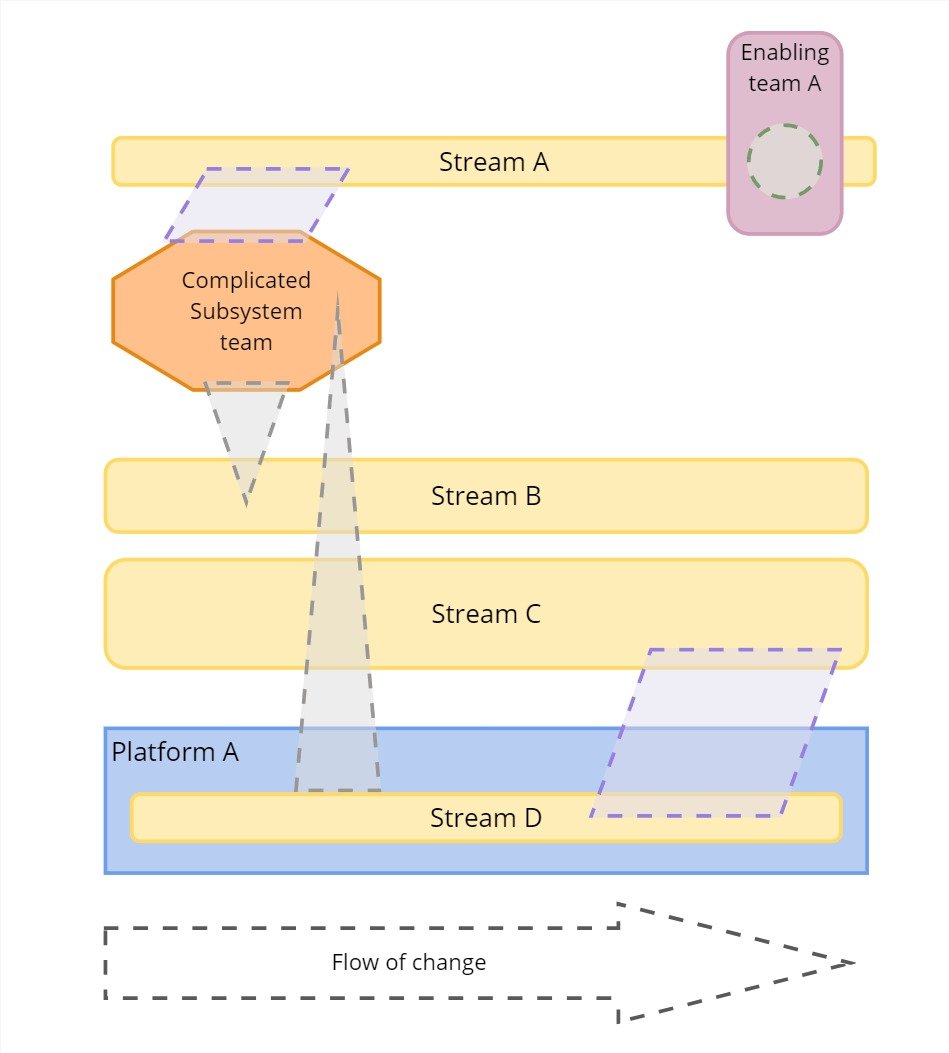Team Interaction Model
Creating a Team Interaction Model is a vital step in visualizing and understanding how different team types within the Team Topologies framework interact with each other. This model is a blueprint that helps your organization design and implement effective team structures and communication pathways. By using the information from the previous content on team types (Stream-aligned, Enabling, Complicated Subsystem, and Platform teams) and interaction modes (Collaboration, X-as-a-Service, and Facilitating), you can create a diagram that effectively represents the dynamics and relationships between teams in your organization.
Step 1: Identify Your Teams¶
Start by listing out all the teams in your organization and categorizing them according to the four fundamental team types:
- Stream-aligned Teams: Directly deliver value to customers through a continuous stream of work.
- Enabling Teams: Provide expertise and support to Stream-aligned Teams, helping them overcome obstacles.
- Complicated Subsystem Teams: Specialize in managing complex technical components.
- Platform Teams: Develop and maintain a platform of services and tools used by other teams.

Step 2: Define Interaction Modes¶
For each team, define the primary interaction modes they use to communicate and collaborate with other teams:
- Collaboration: Teams work closely together on specific projects or objectives.
- X-as-a-Service: One team provides a service that other teams use, minimizing direct interaction.
- Facilitating: One team helps another improve or overcome challenges through guidance and support.
Step 3: Map Interactions Between Teams¶
Using a diagramming tool like Miro or a whiteboard, create a visual representation of your organization’s teams and how they interact.
When creating the visual representation, make sure you adhere to the following schema for team types and interaction modes:
- Platform teams should always have square corners
- Stream-aligned teams should always be horizontally aligned with rounded corners
- Enabling teams should always be vertically aligned with rounded corners
-
Complicated subsystem teams should always be an octagon
-
Collaboration should be indicated using a parallelogram
- Facilitation should be represented using a circle
- X-as-a-Service should be represented with a triangle, with the point of the triangle indicating the direction of the service being provided

Step 4: Highlight Platforms and Services¶
Within your diagram, highlight any platforms or services provided by the Platform Teams. Show which Stream-aligned Teams or other team types depend on these services. This step is crucial for visualizing the support structure that enables teams to work efficiently.
Step 5: Validate the Model with Stakeholders¶
Share the initial version of your team interaction model with key stakeholders and team members for feedback. Ensure the model accurately represents the intended interactions and supports your organizational goals.
Step 6: Iterate and Refine¶
Based on feedback, refine and update the model as necessary. Consider how changes in team structure, technology, or business objectives might affect interactions and update the model to reflect these changes.
Step 7: Use the Model for Continuous Improvement¶
Regularly review and update your team interaction model as part of your organization's continuous improvement processes. Use it as a tool to identify potential bottlenecks, inefficiencies, or opportunities for enhancing collaboration and delivery efficiency.
Example Team Interaction Model¶
Below is a hypothetical organization's Team Interaction Model. Using the shapes guide from Step 3, you can identify four Stream-aligned Teams and one each of an Enabling Team, Complicated Subsystem Team, and a Platform Team.
- The enabling Team is operating in a facilitation mode with Stream-aligned Team Stream A.
- The Platform Team is operating in a X-as-a-Service mode for the Complicated Subsystem Team and three of the Stream-aligned Teams: Stream B, Stream C, and Stream D.

Can you identify other interactions?
In the model diagram above, there are other interactions between the teams taking place aside from what is listed. Can you identify them all?
Additional Resources¶
For a more in depth guide on how to create a team interaction model for your organization, or any other related content, check out the additional resources below: